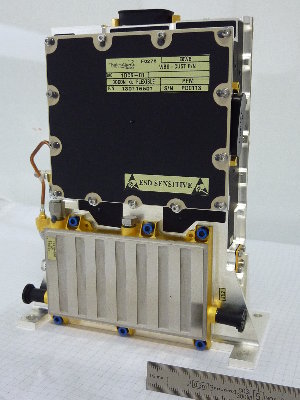
When the Eutelsat 8 West B satellite was launched from Kourou, French Guyana, on 20 August by Ariane 5, its payload included advanced interference-mitigation capabilities, an increasingly desirable feature for telecommunications satellites over North Africa and the Middle East, where politically motivated signal jamming has been an issue in recent years. Designed primarily to serve Direct-to-Home TV markets in this region, Eutelsat 8 West B is equipped with 40 physical Ku-band transponders, thereby substantially increasing the company’s capacity for the fast-growing 7/8°West video neighbourhood.
The interference-mitigation capability was developed in an ARTES 3-4 activity by Thales Alenia Space with the support of the French space agency, CNES. It gives Eutelsat great flexibility in the uplink frequencies the satellite uses.

“This function involves embarking new-generation frequency converters behind the satellite’s receive antennas,” Eutelsat said in a statement. “This will put Eutelsat in the unique position to be able to change the frequency of an uplink signal without any impact on the downlink frequency received by user terminals, marking a major breakthrough in the bid for continuity of service for broadcast signals jammed by rogue uplink signals.”
While the new TAS Ku-band flexible frequency converter can be used by satellite operators to mitigate deliberate jamming, it has other important uses as well. Frequency converters give operators great flexibility when changing orbit slots or adapting to unforeseen changes in the market.
The new unit was included in the payload Eutelsat 8 West B as part of the ARTES Atlas programme element, which supports first flight opportunities on commercial telecom satellites for newly developed or updated components.
“When it became known that the TAS flexible frequency converter was to be given its first flight opportunity on the Eutelsat mission, this gave several other customers the confidence to order it for forthcoming commercial missions,” says Florence Valent, project manager at TAS. “We have since been very successful with the commercialisation of this equipment, with about 35 sold and additional orders under consideration”.
“The vast majority of Ku-band telecommunications satellites currently in orbit are based on a conventional payload architecture with fixed coverage and fixed uplink and downlink frequencies,” says Valerie Dutto, Payload Engineer at ESA. “Enhancing capacity and flexibility is one of the most important challenges for new-generation payloads. Through the ARTES programme, ESA supports the competitiveness of its Member States’ satellite industry in the growing market for highly flexible payload solutions.”




